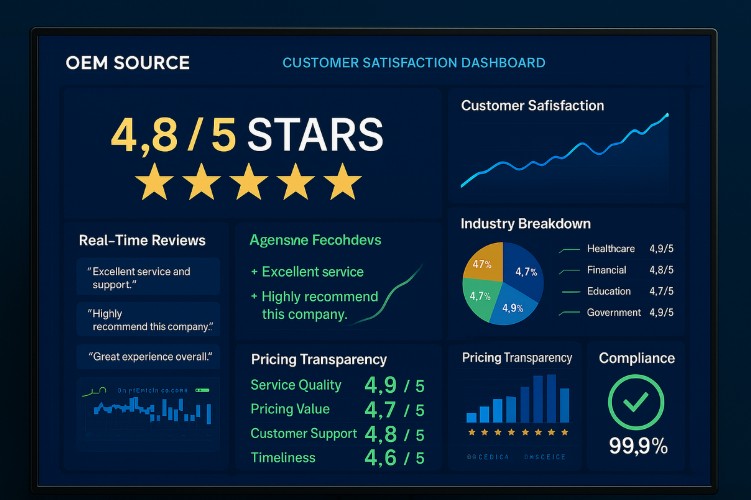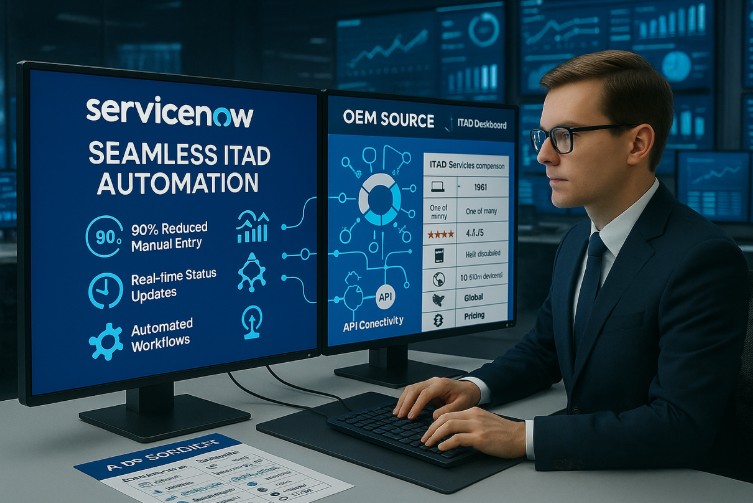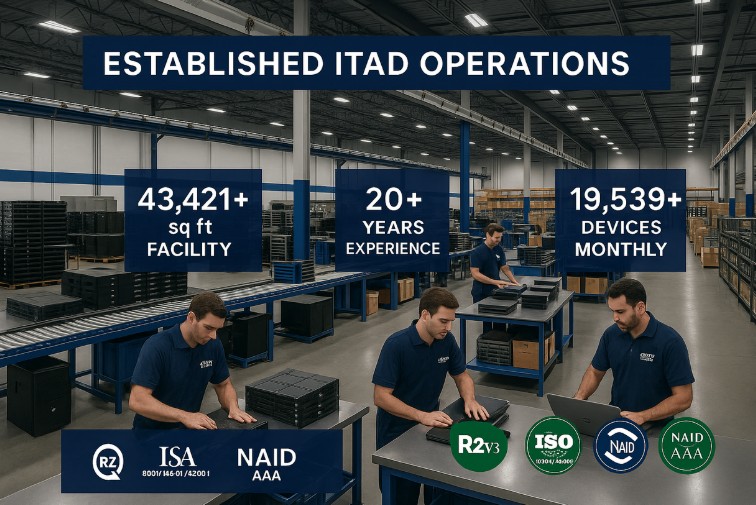Managing end-of-life (EOL) IT assets is a growing challenge for businesses in 2025. With rising pressure to safeguard data, maintain compliance, and minimize environmental impact, organizations must approach IT asset disposition (ITAD) with precision. A well-structured ITAD plan helps protect sensitive information, control maintenance costs, and advance sustainability goals.
According to runZero, nearly 16% of systems connected to the internet are operating beyond their extended EOL dates, exposing them to potential security breaches and regulatory violations. Additionally, predictive maintenance technologies can significantly reduce maintenance expenses, making proactive asset management not just ideal, but essential.
Understanding IT Asset Disposition
IT asset disposition refers to the processes involved in securely and responsibly retiring IT assets that are no longer in use. This includes decommissioning, data destruction, asset recovery, recycling, and disposal.
Organizations must ensure that their ITAD strategies comply with data protection laws such as GDPR or HIPAA, as well as environmental standards like R2. Failure to do so can result in hefty fines and reputational damage.
Additionally, ITAD plays a critical role in preventing data leaks. Legacy servers, laptops, and mobile devices often retain residual data that can be exploited if not properly erased or destroyed. Partnering with a certified vendor ensures a secure chain of custody and clear traceability for each asset.
ITAD also creates opportunities to reclaim residual value from retired equipment. Some devices can be refurbished, resold, or donated—extending their useful life and helping to offset replacement costs.
The Importance of Managing End-of-Life Technology
Outdated hardware is more than a technical liability; it also poses a significant security risk. Once devices reach EOL status, manufacturers stop providing patches and security updates, leaving them vulnerable to breaches. This creates an opportunity for attackers to exploit outdated software or hardware, especially in organizations without robust cybersecurity defenses.
A failure to manage EOL assets can also disrupt service delivery. IT outages, degraded system performance, and unsupported technologies contribute to decreased productivity and lower customer satisfaction.
Enhancing Security Through Proper Disposition
Secure ITAD practices, including certified data destruction and chain-of-custody documentation, are essential for protecting sensitive information. Methods such as on-site or off-site physical destruction, along with Certificates of Destruction, help demonstrate compliance with data protection laws.
Companies should formally include disposition procedures in their cybersecurity policies. This ensures that every retired asset undergoes secure data sanitization or destruction before it leaves the organization. Common tools include degaussers, shredders, and data-wiping software compliant with NIST standards.
IT teams must also train employees on asset retirement protocols. This includes removing credentials, unlinking cloud accounts, and disabling remote access before decommissioning.
Reducing Maintenance Costs
Aging systems are more expensive to maintain and support. They require frequent repairs, special parts, or extended service contracts all of which can inflate IT budgets. According to research by the U.S. Department of Energy, companies that invest in predictive and preventive maintenance lower their overall maintenance costs by up to 40%.
Maintenance costs aren’t just financial—they also consume valuable IT resources. Teams that spend less time on reactive fixes can focus more on strategic initiatives.
Improving Budget Planning and Compliance
Proactive EOL management helps organizations anticipate hardware replacement needs and avoid unplanned expenses. It also ensures adherence to internal IT policies and external regulations. By documenting each step of the ITAD process, companies can minimize the risk of regulatory fines, audit failures, and reputational damage.
When paired with IT asset management (ITAM) tools, forecasting asset lifecycle trends improves long-term budget accuracy. Companies can plan refresh cycles 3–5 years in advance, allowing for phased purchases and reducing the impact of bulk procurement.
Key Strategies for Effective EOL Management
To manage EOL IT assets efficiently, organizations should incorporate the following best practices:
Maintaining a Comprehensive Hardware Inventory
Accurate asset tracking is the foundation of a successful ITAD program. Modern asset management systems provide real-time visibility and help prevent devices from being overlooked or mishandled..
An up-to-date inventory should include:
- Asset ID and physical location
- Assigned user or department
- Warranty and support expiration dates
- Maintenance history and service records
- Software licenses and configuration data
This level of detail ensures a clear understanding of which assets are active, idle, or approaching end-of-life. Comprehensive inventories also support compliance during audits.
Monitoring Manufacturer Notifications
Vendors regularly release EOL announcements that specify when devices will no longer receive updates or support. Tracking these notifications enables IT teams to plan proactive upgrades and avoid reliance on unsupported hardware. Businesses should subscribe to vendor bulletins and integrate these updates into their IT roadmaps.
Some vendors offer extended support for legacy systems, but these should be viewed as temporary solutions rather than long-term strategies.
Prioritizing Equipment Replacements
Not every asset requires immediate replacement. Apply a risk-based approach to prioritize replacement based on security implications, compliance obligations, and the asset’s operational significance.
Assets tied to critical infrastructure or sensitive data should take precedence. Key evaluation criteria include:
- Device age and frequency of use
- Business function and operational impact
- Security vulnerabilities and performance issues
- Current support and update status
Setting Strategic Budgets
Align ITAD and refresh planning with your organization’s long-term goals. Building asset disposition into your annual budget helps minimize unplanned downtime and emergency expenditures.
Collaborate with finance and operations teams to ensure ITAD plans are realistic and sustainable. Phasing replacements across quarters or fiscal years can ease financial pressure and improve resource allocation..
Utilizing IT Asset Management Software
Software tools like InvGate Asset Management help streamline lifecycle tracking, automate support expiration alerts, and generate actionable reports. These platforms also integrate with service desks to align ITAD efforts with incident and service management workflows.
Key dashboard features include:
- Asset distribution by department or location
- Upcoming EOL timelines
- Security patch and update status
- Real-time usage and performance metrics
By automating repetitive tasks, IT teams can focus on strategic planning and decision-making while reducing the risk of manual error.
Benefits of Automation in EOL Management
Automation reduces human error, enhances asset visibility, and improves allocation efficiency. System-generated alerts for approaching EOL dates help IT teams stay proactive with replacements and upgrades.
Some platforms leverage machine learning to forecast future maintenance needs, supporting more effective preventive strategies. Integration with cloud environments ensures consistent oversight of both on-premise and remote assets, a critical feature for hybrid workforces..
Real-Time Asset Inventory Visibility
Having real-time visibility into IT assets is essential for making timely, informed decisions. With cloud-based asset tracking tools, IT teams can remotely monitor and manage distributed assets, ensuring no asset goes overlooked or unmanaged.
In the age of hybrid work, remote asset oversight has become a critical capability. Visibility tools allow organizations to track laptops, desktops, routers, and mobile devices even when they’re operating outside the corporate network.
Comprehensive Guide to Asset Lifecycle Management
Asset lifecycle management (ALM) involves overseeing IT assets from acquisition to disposal. The typical lifecycle includes:
Planning Phase
Define business needs, forecast usage, and determine procurement strategies. Consider factors such as total cost of ownership, vendor contracts, and future scalability.
IT leaders must also account for technology compatibility, energy efficiency, and potential vendor lock-in when selecting new solutions.
Procurement Phase
Select vendors, negotiate pricing, and configure assets to meet organizational standards. Initiate asset tagging and inventory tracking at this stage.
Involving stakeholders from IT, finance, and compliance teams ensures that new assets align with enterprise objectives.
Operation Phase
Deploy, maintain, and support assets. Monitor performance, apply patches, and conduct routine audits to ensure functionality and compliance.
This phase includes:
- Tracking software licenses
- Monitoring device health and uptime
- Updating asset records after changes
- Patching known vulnerabilities
Disposal Phase
Retire outdated assets through secure ITAD methods. This stage includes data wiping, asset recovery, certified recycling, and documentation.
Maintaining records of each step creates an audit trail that supports internal policies and external regulations.
Integrating EOL Management into ITAM Systems
Integrating EOL processes into ITAM systems ensures a seamless transition from active use to secure disposition.
Key features to consider include:
- Automated asset discovery and classification
- Alerts for upcoming EOL and support expiration
- Integration with ticketing systems for streamlined tracking
- Centralized dashboards for full lifecycle oversight
- Cross-platform visibility and role-based access controls
This alignment enables IT teams to proactively address hardware challenges before they escalate into emergencies.
Tracking and Optimizing Asset Performance
Performance data plays a critical role in identifying underperforming assets and optimizing refresh cycles. ITAM systems can log repair histories, support tickets, and utilization rates to guide lifecycle decisions.
Useful metrics to track include:
- Frequency of downtime or tickets
- User satisfaction ratings
- Total cost of ownership over time
- Battery health or thermal performance logs (for mobile devices)
These insights support more strategic planning and help identify devices that no longer deliver adequate value or functionality.
Leveraging ITAM for Lifecycle Optimization
Proper use of ITAM allows businesses to extend asset lifecycles through preventive maintenance, reduce depreciation, and maximize return on investment.
By analyzing performance trends, IT teams can phase out underused assets and redeploy high-performing ones where they’re most needed. Organizations can also identify alternative use cases or evaluate resale opportunities to extract additional value.
Mitigating Risks with ITAD
Neglected EOL assets increase the likelihood of:
- Data breaches caused by unpatched vulnerabilities
- Regulatory penalties due to non-compliance
- Operational disruptions and reduced productivity
- Damage to brand reputation and customer trust
Integrating ITAD into your security and compliance strategy helps close these gaps. Partnering with certified recyclers ensures that all retired assets are destroyed or repurposed in accordance with legal and ethical standards.
Managing Outdated Technology Risks
Approximately 16% of internet-exposed devices are still operating beyond their extended EOL status. These systems lack critical security patches and present exploitable vulnerabilities.
To mitigate risk:
- Replace unsupported assets without delay
- Use third-party maintenance solutions for short-term support
- Segment outdated systems away from sensitive infrastructure
- Implement monitoring protocols for legacy devices still in use
Ensuring IT Security in Disposition Processes
IT security doesn’t end when a device is decommissioned. Secure disposition should include:
- Certified data destruction tools
- Physical destruction when required
- Documented chain-of-custody procedures
- Encryption and access removal prior to disposal
Encrypting data before wiping or destroying devices adds an extra layer of protection in case hardware is intercepted or mishandled during the recovery process.
Promoting Sustainable IT Solutions
Sustainability has become a core consideration in modern ITAD. Organizations are under growing pressure to reduce e-waste and support the circular economy.
E-Waste Recycling Processes
Partner with certified recyclers who follow standardized recycling procedures and provide verifiable Certificates of Destruction. This protects brand integrity and environmental regulations.
Track recycling volumes over time, and explore donation or refurbishment programs for equipment that remains functional.
The Role of Third-Party Maintenance
Third-party maintenance (TPM) offers a cost-effective solution for extending asset life beyond manufacturer support timelines.
Key benefits include:
- Delaying large capital investments
- Reducing unplanned downtime
- Flexible service-level agreements (SLAs)
- Coverage across diverse IT infrastructures
Environmental Responsibility in ITAD
Environmental compliance involves meeting state and federal recycling laws, minimizing hazardous waste, and maintaining detailed recycling documentation. A green ITAD strategy enhances corporate social responsibility efforts and supports long-term brand reputation.
Encouraging employees to promptly return unused or outdated devices also supports sustainability objectives and helps reinforce company-wide environmental goals.
Why Strategic ITAD Is Essential for Modern Business Resilience
IT asset disposition is no longer just an end-of-life task. It’s a strategic imperative. A well-executed ITAD program protects sensitive data, ensures regulatory compliance, and reinforces sustainability goals. As organizations adopt more integrated lifecycle management strategies, EOL planning will become a cornerstone of operational continuity and risk mitigation.
By embedding ITAD into your broader IT and security roadmap, you’re not just retiring old equipment—you’re actively protecting your infrastructure, reputation, and bottom line.
Frequently Asked Questions
What is asset management for end-of-life?
It involves tracking assets, planning, and responsibly disposing of assets nearing the end of their useful life. This includes ensuring data security, cost-effective replacement, and environmentally responsible disposal.
What is lifecycle management of IT assets?
Lifecycle management covers all stages of an asset’s life from planning and procurement to operation and retirement. It helps ensure efficient use, cost control, and secure end-of-life handling.
What should an organization do with EOL devices?
Options include redeployment, certified recycling, resale (if secure), or donation. Before any transfer, proper data destruction and security checks must be performed.
How does IT asset disposition support compliance and security?
ITAD ensures retired devices are handled according to data protection and environmental regulations. Certified processes like data sanitization, chain-of-custody tracking, and destruction documentation help organizations meet compliance requirements and reduce the risk of data breaches.
What are the five stages of asset management?
- Planning
- Procurement
- Operation
- Maintenance
- Disposal
Each stage contributes to maximizing asset value and minimizing risks throughout the asset’s lifecycle.





